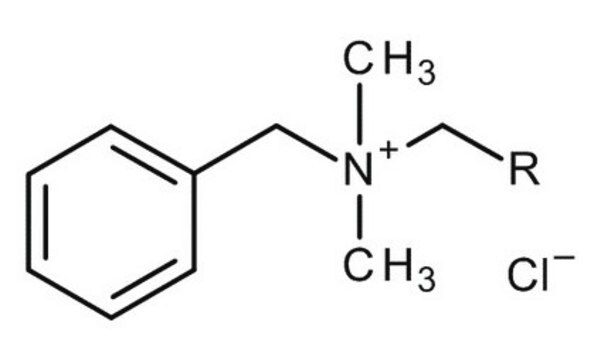B6295
Chlorure de benzalkonium
BioXtra
Synonyme(s) :
Chlorure d'alkylbenzyldiméthylammonium, Chlorure d'alkyldiméthylbenzylammonium
About This Item
Produits recommandés
Description
cationic
Niveau de qualité
Gamme de produits
BioXtra
Essai
95.0-105.0% (calculated on dry substance)
Forme
(Solid or Semi-Solid or Viscous Liquid)
Impuretés
≤0.001% Phosphate
≤0.1% Insoluble matter
≤10% water
Résidus de calcination
≤2%
Traces d'anions
sulfate (SO42-): ≤0.05%
Traces de cations
Al: ≤0.0005%
Ca: ≤0.0005%
Cu: ≤0.0005%
Fe: ≤0.0005%
K: ≤0.005%
Mg: ≤0.0005%
Na: ≤0.02%
Pb: ≤0.001%
Zn: ≤0.0005%
Chaîne SMILES
[Cl-].CCCCCCCCCCCCCC[N+](C)(C)Cc1ccccc1
InChI
1S/C19H34N.ClH/c1-4-5-6-7-8-9-10-14-17-20(2,3)18-19-15-12-11-13-16-19;/h11-13,15-16H,4-10,14,17-18H2,1-3H3;1H/q+1;/p-1
Clé InChI
TTZLKXKJIMOHHG-UHFFFAOYSA-M
Vous recherchez des produits similaires ? Visite Guide de comparaison des produits
Description générale
Application
Clause de non-responsabilité
Mention d'avertissement
Danger
Mentions de danger
Conseils de prudence
Classification des risques
Acute Tox. 4 Dermal - Acute Tox. 4 Oral - Aquatic Acute 1 - Aquatic Chronic 1 - Eye Dam. 1 - Skin Corr. 1B
Code de la classe de stockage
8B - Non-combustible corrosive hazardous materials
Classe de danger pour l'eau (WGK)
WGK 2
Point d'éclair (°F)
Not applicable
Point d'éclair (°C)
Not applicable
Équipement de protection individuelle
Eyeshields, Faceshields, Gloves, type P3 (EN 143) respirator cartridges
Faites votre choix parmi les versions les plus récentes :
Déjà en possession de ce produit ?
Retrouvez la documentation relative aux produits que vous avez récemment achetés dans la Bibliothèque de documents.
Les clients ont également consulté
Notre équipe de scientifiques dispose d'une expérience dans tous les secteurs de la recherche, notamment en sciences de la vie, science des matériaux, synthèse chimique, chromatographie, analyse et dans de nombreux autres domaines..
Contacter notre Service technique







